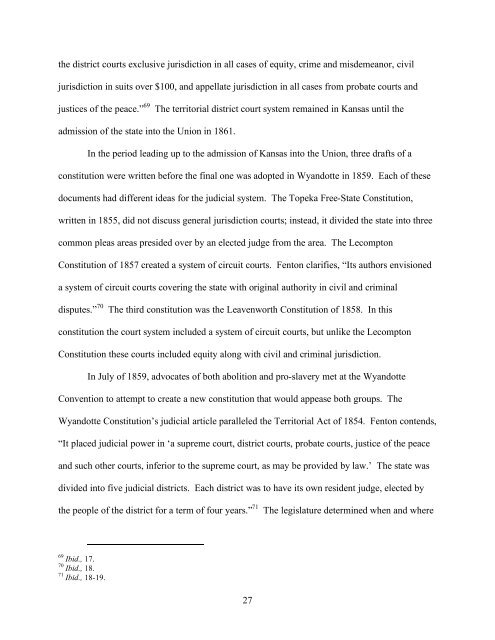SELFISH INTENTIONS - K-REx - Kansas State University
SELFISH INTENTIONS - K-REx - Kansas State University
SELFISH INTENTIONS - K-REx - Kansas State University
Create successful ePaper yourself
Turn your PDF publications into a flip-book with our unique Google optimized e-Paper software.
the district courts exclusive jurisdiction in all cases of equity, crime and misdemeanor, civil<br />
jurisdiction in suits over $100, and appellate jurisdiction in all cases from probate courts and<br />
justices of the peace.” 69 The territorial district court system remained in <strong>Kansas</strong> until the<br />
admission of the state into the Union in 1861.<br />
In the period leading up to the admission of <strong>Kansas</strong> into the Union, three drafts of a<br />
constitution were written before the final one was adopted in Wyandotte in 1859. Each of these<br />
documents had different ideas for the judicial system. The Topeka Free-<strong>State</strong> Constitution,<br />
written in 1855, did not discuss general jurisdiction courts; instead, it divided the state into three<br />
common pleas areas presided over by an elected judge from the area. The Lecompton<br />
Constitution of 1857 created a system of circuit courts. Fenton clarifies, “Its authors envisioned<br />
a system of circuit courts covering the state with original authority in civil and criminal<br />
disputes.” 70 The third constitution was the Leavenworth Constitution of 1858. In this<br />
constitution the court system included a system of circuit courts, but unlike the Lecompton<br />
Constitution these courts included equity along with civil and criminal jurisdiction.<br />
In July of 1859, advocates of both abolition and pro-slavery met at the Wyandotte<br />
Convention to attempt to create a new constitution that would appease both groups. The<br />
Wyandotte Constitution’s judicial article paralleled the Territorial Act of 1854. Fenton contends,<br />
“It placed judicial power in ‘a supreme court, district courts, probate courts, justice of the peace<br />
and such other courts, inferior to the supreme court, as may be provided by law.’ The state was<br />
divided into five judicial districts. Each district was to have its own resident judge, elected by<br />
the people of the district for a term of four years.” 71 The legislature determined when and where<br />
69 Ibid., 17.<br />
70 Ibid., 18.<br />
71 Ibid., 18-19.<br />
27

















